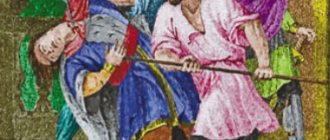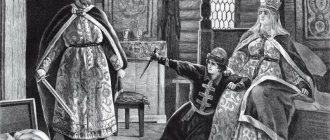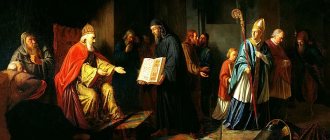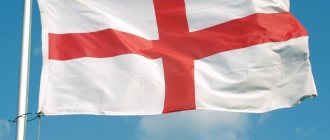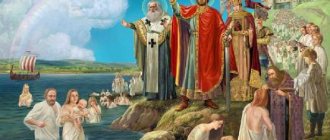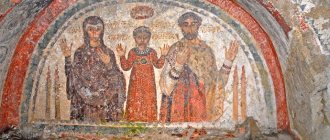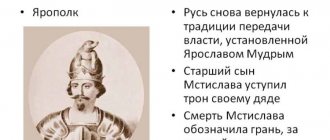They took Olaf's Life - he went furiously into battle, but Dag's flight saved him - Skögul danced
Olaf Haraldsson, nicknamed the Tolstoy during his lifetime, and after his death the Saint, fell in 1030 at the Battle of Stiklastadir, defending his right to be king of Norway. The united army of the Norwegian aristocracy, dissatisfied with Olaf’s harsh centralization policy and supporting the Danish king Canute the Great, defeated the Swedish warriors who came to the aid of the legitimate autocrat. However, the aspirations of the Bonds and Lendermans were not destined to come true - Canute began to tighten the screws so much that after some time the same aristocracy rebelled again. but already against the Danish dynasty.
Preface
In 1054, a sad event occurred in the history of the Universal Christian Church: it split into the Western, subordinate to the Pope (the current Roman Catholic Church), and the Eastern (Orthodox). But until 1054 it was a single Church, and all its saints belong to the host of saints of the Orthodox Church. However, the memory of many of these saints, who became famous in Western and Northwestern Europe, gradually faded. But some of them were deeply revered in Rus', and even in the center of Orthodoxy - Constantinople. Such half-forgotten saints include the Holy Righteous Martyr King Olaf, patron of Norway and friend of the Russian Grand Duke Yaroslav the Wise .
The last saint of the undivided Church
Olaf's glorification took place on August 3, 1031, that is, before the Great Schism of 1054. It happened like this: a year after the death of the king, they decided to move his remains. When the burial was opened, it turned out that the body remained incorrupt. He was elevated to sainthood by the local bishop and became the last common saint for the Western and Eastern churches.
His canonization by Pope Alexander III took place in 1164, after which he began to be revered as the eternal heavenly patron of Norway - perpetuus rex Norvegiae. In Orthodoxy he is revered as St. Olaf of Norway.
According to the canon, on icons “it is appropriate to depict St. Olaf as red-haired, so that it can be seen that this blessed king comes from the Varangians.” He is depicted wearing a crown and holding in his right hand a battle ax or ax with which his knee was struck. In the left hand there are royal regalia (a scepter or an apple orb), or an ampulla - a vessel filled with incense. With his feet he tramples a dragon with a human face, which symbolizes paganism.
Sometimes, instead of an ax, a spear is depicted in the saint’s hand, less often - a sword with which the wounds were inflicted on him, and instead of a dragon - a snake or a demon in a different guise. Deciphering the iconography of St. Olaf is sometimes difficult. The most unusual thing is when the dragon he tramples has the face of Olaf himself. Perhaps this symbolizes the pagan past of the saint, or a demon in his guise, who committed acts that discredited the king, and whom the saint defeated at the cost of shedding his blood.
The fate of St. Olaf, like the fortress named after him, is closely connected with Russian history. He was a friend of Prince Yaroslav the Wise. Very warm feelings and mutual affection connected him with the prince’s wife, Ingigerda (Irina) . In Northern Rus', the name of St. Olaf was very revered, but the memory of him gradually weakened. In Novgorod, already at the end of the 11th century, there was the Church of St. Olaf, built for Gotlandic merchants. Temples in his honor were erected in Staraya Ladoga and even in Constantinople.
I would like to tell you more about the life of St. Olaf and his stay on Russian soil.
Orthodoxy in the city of the “eternal king of Norway”
Priest Alexander Volokhan, rector of the parish of St. Anne of Novgorod in the ancient capital of Norway, Trondheim, talks about the peculiarities of life in Norway, the Norwegians’ perception of Russians and Orthodoxy, the Norwegian heritage of St. Tryphon of Pechenga and St. Olaf of Norway.
Priest Alexander Volokhan. Photo: Arkady Ryabichenko
To the “Varangians” from... Lvov
– How did an Orthodox person end up abroad, in Norway?
– I ended up in Norway, according to usual ideas, by accident. My wife, a candidate of biological sciences, was offered a position in the laboratory of the Institute of Biotechnology at the Norwegian University of Science and Technology in 2002, where they were developing anti-cancer drugs. Our family was in a difficult economic situation at that time, and we decided to go to Norway only for a couple of years. At that time, having graduated from the Moscow State Law Academy, I received theological education in absentia at the Orthodox St. Tikhon's Theological Institute in Moscow. We lived in Lvov, where there was only one church of the Russian Orthodox Church; With an excess of clergy and parishioners, it was difficult to do anything to develop church life in this city - the local authorities strongly opposed it. There was no Orthodox parish in Trondheim, and this was, of course, bad, but also good: maybe Orthodoxy would be in demand here, in the first capital of the country, the city of the “eternal king of Norway,” the centuries-old location of his holy relics? The Orthodox parish in Oslo is dedicated to St. Princess Olga, and my wife's name is Olga, and we thought that this might not be a coincidence. I consulted with priests whom I trusted, and they decided that the trip could be useful both for me and, perhaps, for the missionary service of the Church. That's how I ended up in Norway.
Saint Olaf of Norway is the patron saint of Vyborg, and celebrations in his honor are regularly held here
Initially, after completing a full year's course in Norwegian at the city university, I worked in a school in Trondheim as a teaching assistant in a classroom with foreign children. At the same time, he helped the rector of the Orthodox parish in Oslo, Abbot Kliment (Huhtamäki)1 at the services that he performed, coming to Trondheim three or four times a year. On big holidays, our family went to services in Oslo, where, with the blessing of the abbot, I became a sexton, conducted catechetical conversations, and sang in the choir. A few years later, Father Clement asked me if I was ready to serve in Norway as a priest, and I agreed. After the approval of my candidacy by the then head of the Department for External Church Relations, Metropolitan Kirill of Smolensk and Kaliningrad (now His Holiness Patriarch) and an interview with his deputy, Bishop Mark of Yegoryevsk (now Metropolitan of Ryazan and Mikhailovsky), in 2006 my diaconal ordination took place in Smolensk, which was performed by Bishop Kirill personally during the anniversary celebrations on the occasion of his 60th birthday. And at the end of February 2007, on the Sunday of the Triumph of Orthodoxy, in Smolensk, Bishop Ignatius (Punin) of Vyazemsky ordained me to the priesthood of priest. Now he heads the Vyborg diocese, and I see a definite sign in this, because the heavenly patron of Vyborg is St. Olaf of Norway. There is a castle there, the tower of which is called Olaf’s Tower; On the initiative of the rector of the St. Elias Church, Archpriest Igor Aksenov, a great popularizer of St. Olaf, celebrations dedicated to the heavenly patron of Vyborg are regularly held in the city.
– Father Alexander, what were your first impressions of Norway?
– Definitely bright, although I could not delve into all aspects of Norwegian life then. There was a contrast with Western Ukraine, where I came from, where even speaking Russian had to be done with caution. But here the Norwegians spoke Norwegian, and the foreigners spoke their language freely and without fear everywhere - on the street and at home. In addition, in Norway I especially liked, despite all the modernity of life, the closeness of people to nature, the massive commitment to walks and hikes of people of all ages and classes - children in schools, pensioners, and entire families - to the mountains, forests, and the sea. I myself have always been a purely urban, bookish person, and now every day for an hour or two, or even longer, I walk with my dog in the mountain forest, swim in the fjord, and go skiing and skating in winter.
Traditional blessing of the waters of the Norwegian Sea
Two sides of the coin
– The rector of the Sergius parish in Stockholm, Father Vitaly Babushin, categorically views Sweden as Sodom and Gomorrah. Do you think there are dark sides to life in Norway?
– Yes, of course, as in any society. Although Father Vitaly and I apparently have different starting points. He came to Sweden already as a priest, after ten years of service in Russia, and I arrived in Norway in a slightly different capacity. Besides, for me it was a bright world, more connected with nature, and at first we didn’t really communicate with the Norwegians themselves. In Norway, many people advocate traditional values, but liberal propaganda and legislation - that very “fly in the ointment” - are gradually transforming people’s consciousness and behavior. Therefore, of course, I talk about the spiritual dangers of life in the West in private and public conversations, and in sermons.
At the same time, Norway also has something that we still lack in Russia. Now I’m in Russia, on average two or three times a year, and sometimes you’re just surprised that in the store at the checkout they look at you as if you want to steal something. In the USA, for example, there is a “duty” smile; we may have another extreme. But in Norway it’s something in between. It is difficult to count on a sincere, open attitude from the first steps here, but at the same time, unlike the Americans, people here will sincerely welcome you. The immigrant issue in Europe is now the most pressing, and not everyone is happy with foreigners. But in general, the Norwegians we met were hospitable and friendly, although this manifested itself differently than in Russia.
– In Scandinavia, there are definitely anti-Christian tendencies that come from certain influence groups, bearers of certain ideas. The masses, people from the outback, often have completely different views on a number of issues, from sex education for schoolchildren to the attack of Russians, which local politicians like to scare fellow citizens with.
- This is true. There is a public sphere where everything is regulated by law, but at the informal level the majority is critical of the promotion of same-sex relationships, including children. Thus, among schoolchildren the word “homo” is considered an insult.
They tell you: either you are with the Nazis or with the liberals - choose. Everything is simplified
This topic is often presented in this way: are you with those who are ready to take a stone and kill these people, or are you with those who say: “Well, let them live, since they are like that”? They tell you: either you are with the Nazis or with the liberals - choose. Everything is simplified, the spiritual and moral dimension, God’s truth are absent in this alternative. Personally, as a Christian, I definitely wouldn’t go for stoning, but that doesn’t solve the questions. I know that many Orthodox priests have a negative impression of life in the West. Yes, there are such moments: propaganda of same-sex cohabitation, fornication, love of money - to which we cannot indifferently close our eyes, without giving them an evangelical assessment. But in anti-Western criticism there are also distortions.
Norway has very good public control, which results in two sides of the same coin. There is a kind of risk of denunciation (there are cases of abuse), but at the same time, in local schools, children are taught not to sort things out in fights around the corner, but are offered to tell the teacher about the problem and disperse peacefully. The legal consciousness of the population is very highly developed here. Although these and other situations, for example with overly vigilant neighbors, may in some ways even resemble the USSR. At the same time, I cannot say that we don’t have anything like this in Russia now: when a crime is committed, everyone who can say something is asked for information; The social factor is important both for the detection and prevention of crime.
– And still, we have few people willing to voluntarily tell something about someone to the authorities...
- Yes it is. But this is largely due to poor witness protection. As for Norway, we can summarize it this way: everything here is not as scary as is sometimes reported in our media. We can learn some aspects of their lives, they, in turn, can also learn from us, there are points of contact, the common history of our peoples, for example. Demonizing each other is probably a dead end.
There are many positive things about Norway and these points cannot be ignored. In Norway, by the way, special work is being done among students to ensure that they do not have abortions; families and single mothers receive serious support from the state. The one-time benefit for the birth of a child is very large. Depending on which parties are represented in parliament, the amount of subsidies may vary. Previously, as far as I know, 3,000 crowns were paid monthly for each child upon reaching the age of three3. If the child does not go to kindergarten, then additional funds are paid, including the mother’s full salary for up to eight months. Norwegian men can also take paid parental leave.
As for freedom of expression for people who share conservative values, it exists. Thus, recently a film was broadcast on central channels about the Protestant priest Burr Knutsen, who actively fought against abortion. Another example: when the new marriage law was passed, thousands and thousands of Norwegian Christians protested unhindered outside the parliament in Oslo. In our Orthodox Church, a woman cannot be a priest, which, of course, does not agree with liberal guidelines for total equality of the sexes (in the Protestant Norwegian Church there are women priests and even bishops). But there is no pressure on us about this yet; the state makes an exception for the religious activities of cultural and ethnic minorities and pays us subsidies, like all other religious groups in Norway.
"The Eternal King of Norway"
St. Olaf on a fresco in one of the Swedish churches
–
Father Alexander, you mentioned Saint Olaf of Norway.
Who is he, why do they pray to him, including Orthodox Christians? – This figure is very significant for the Christian history of Norway. Olaf the Baptist not only sat in the fortress and issued decrees that it was necessary to be baptized, but he personally carried out the Christianization of the country. Let's start with the fact that our parish is named in honor of Anna of Novgorod - the Orthodox saint who united Rus' and Scandinavia. Anna of Novgorod is the Swedish princess Ingigerda, who became a Christian and, by the decision of her father Olaf Shetkonung, married Prince Yaroslav the Wise. It was she who was initially promised to Olaf of Norway as his wife, but due to changed circumstances, he married her half-sister Astrid.
Saint Olaf, when he was driven out of the country by the nobility, lived for some time in Rus', in Veliky Novgorod. One of his miracles was performed there, and there he left his son, later King Magnus I the Good, to be raised there. If we supplement this series, then the daughter of saints Yaroslav the Wise and Anna of Novgorod, Elizabeth, then became the Queen of Norway.
Why do we clearly consider Olaf to be an Orthodox saint? He lived and gave his life before the Great Schism, and in the academic and priestly environment of our Russian Orthodox Church they confidently say that Olaf of Norway is one of the great saints of his time, quite comparable with other equal-to-the-apostles sovereigns, including the holy Prince Vladimir .
– The parallels between St. Olaf and the Baptist of Rus' suggest themselves...
– So I’ll tell you more: the day of remembrance of Prince Vladimir and the day of the baptism of Rus' is July 28, and the festivities in honor of St. Olaf take place in Trondheim (there is, however, also a difference between the two styles) on July 29. On this day, Saint Olaf died in Stiklestad, a hundred kilometers from Trondheim. In 2013, Bishop Mark of Yegorievsky, at that time the head of the Moscow Patriarchate’s Office for Foreign Institutions, consecrated the foundation stone and site in Stiklestad for the construction of an Orthodox church. It is symbolic in its own way that the consecration took place in the afternoon of July 28, that is, at the junction of the day of the baptism of Rus' and the day of St. Olaf. The consecration of the already built temple in honor of St. Olaf of Norway took place on October 16, 2014, on the day of the 1000th anniversary of his baptism4. We have plans to place in this temple icons of both the holy King Olaf and the holy Prince Vladimir, already painted for our parish by the Georgian icon painter Gurgen Chukua, in order to express the historical and spiritual connection of the two equal-to-the-apostles sovereigns of Rus' and Norway.
The iconography of St. Olaf is interesting: on the icon they write “St. Olaf, eternal king of Norway.” In most cases, wherever the veneration of St. Olaf was widespread and his icons, as well as wooden and stone sculptural images were preserved (I saw them in museums in Oslo, Stockholm, Copenhagen, Helsinki, Reykjavik), Olaf on them tramples under his feet a serpent-dragon with his head man and the face of the king himself - this serpent symbolizes his pagan past. This is how the change that occurred with Olaf after baptism is presented - the same thing happened with the holy Prince Vladimir after baptism and adoption of Christianity.
Many liberal historians today try to downplay Olaf's role, portraying him as a tyrannical despot. He, of course, baptized Norway with a cross and a sword: “whoever is not a friend to the prince...” But there was another aspect: Olaf, driven by the high evangelical ideal, under pain of death, resolutely forbade grave sins, including socially dangerous ones: fornication, murder children - and before that, the Norwegians often left weak children in the forest to die. For the selfless king-baptizer, these were necessary measures aimed at realizing God's truth. And that really captivated me about him.
According to the law, the kings of Norway (and Norway is still a monarchy) are always crowned in Trondheim and specifically in the Nidaros Cathedral. It is believed that Norway is ruled by Saint Olaf, who is also the heavenly patron of the country and people. And kings are transitory, they are his governors, successors.
Olaf's Trail
– Are the relics of St. Olaf preserved? And if so, where are they located? Is it possible to bow to them?
– Olaf’s relics were kept for centuries in the Nidaros Cathedral; now they are there, but hidden under a bushel since the Reformation.
Nidaros Cathedral
This cathedral is the end point of the pilgrimage route, now revived, and at the state level. In the Middle Ages, Trondheim (then Nidaros) was the most visited place by pilgrims in Northern Europe: believers strove to visit St. Olaf and his holy relics. Since the 16th century, Norway has been a Protestant country for which neither pilgrimage nor the veneration of saints is typical. A number of representatives of the Norwegian Church speak about this with bewilderment: why, besides God Himself, do we honor a certain person, albeit historically significant? In 2010, by decision of the Council of Europe, the pilgrimage route to Trondheim received the status of a cultural heritage site; the revival of the pilgrimage is being carried out with the help of government funding. To some extent, thanks to this government program, we, by the way, received land and funds for the construction of a small temple in Stiklestad dedicated to St. Olaf, although, undoubtedly, many Norwegians and Russians also played a significant role in its appearance on this site.
– Can Orthodox Christians who come to Norway for tourism purposes make a pilgrimage on this trail in its Orthodox understanding?
- Of course they can. The routes are marked on maps and on the ground, and the Norwegians have established a pilgrimage center. Although for them, pilgrimage is something not entirely clear. Norwegians regularly go hiking, but from their point of view, Olaf's trail is still intended for religious people. They say that pilgrimage is a way to know and test oneself, but in our Orthodox understanding, we move to the shrine in order to become closer to the saint to whom we are going. The Norwegians are in search, and I'm glad about that. An example of this is the recent conference “Our Spiritual Roots” at the pilgrimage center of Trondheim, where I was invited by the organizers. At the conference, the Norwegians often spoke, as they say, directly about Orthodoxy.
Orthodox Christians can walk along the trail; part of the way can be done by car. Previously there were three routes: through Oslo-Hamar and further to Trondheim and Stiklestad, and a trail that goes from Sweden through Åre. The routes are now somehow marked, the pilgrimage cross of St. Olaf and memorial badges are being installed. One of our Orthodox Norwegians, Hel Moen (baptized Xenophon), who participated a lot with his father in the construction and transfer of the temple to Stiklestad, is hatching the idea that Orthodox chapels should be built along these routes, and that at the temple itself there would be a a large worship cross, which has long been our common idea.
– The same thought immediately came to me. Or perhaps it’s worth at least installing worship crosses along the way.
– Yes, or worship crosses along the route. I talked about this too: this is the simplest, most realistic option.
– There is currently no information on the trail in Russian. At the tourist office in the Swedish city of Åre, I saw brochures dedicated to St. Olaf in Norwegian, English, Swedish - but not in Russian.
- It's a sad fact. I myself recently learned that Trondheim is one of the few cities in Norway that does not have a sister city in Russia. Perhaps it is worth intensifying cultural exchange with one of the Russian cities. I know that the Russian embassy in Oslo is thinking about this issue.
For my part, I am trying to develop relations between the parish and the Orthodox in Sweden. Since Anna of Novgorod is a saint of our parish5, I have already come several times to the Russian days dedicated to her in the Swedish city of Sigtuna, and participated in Orthodox services together with clergy from Stockholm and Helsinki. I am definitely in favor of us coming from Norway to Sigtuna as pilgrims at least once a year, and for Orthodox Christians from neighboring countries to come to us for St. Olaf’s Days. As a representative of parishes in the Coordination Council of Compatriots in Norway, I regularly raise such questions, but here, as in Russia, unfortunately, a minority goes to churches.
How to pray to St. Olaf?
– Is it possible to find an icon of St. Olaf in Russia? I did not find information about this saint in the Liturgical Calendar.
– There really is no information about him in the calendar, as, in fact, there is no information about many saints of England and Ireland (although a solid book collecting their lives was recently published in London).
In our parish they printed out the icon of Olaf, as well as the icon of St. Anna of Novgorod. In Russia you rarely hear about St. Olaf, much less see his iconographic image. This is partly explained by the fact that we have enough saints of our own, such close and familiar ones. Now that an Orthodox church has been consecrated in honor of St. Olaf in Norway, things may move forward. It is important for us that people in Russia know about St. Olaf.
– Is there an akathist to St. Olaf of Norway?
– There is a troparion and kontakion in Russian, magnification. Through Hierodeacon Gregory (Matrusov), I received the texts of the service to St. Olaf, created by one of the inhabitants of the Holy Trinity Lavra of St. Sergius. But since his memory has not yet been officially established by the hierarchy, these texts have also not yet been approved, although we use them as necessary. On one of the Orthodox websites of parishes in Britain, I also found a complete service to St. Olaf in English by another author.
The Scandinavians glorify Saint Olaf as a martyr king, but we consider him blessed or equal to the apostles
We use part of this service in Stiklestad and Trondheim. Here, by the way, there is an interesting discrepancy: the Scandinavians glorify St. Olaf as a martyr king, but we consider him blessed or equal to the apostles. The greatness also differs: in Norwegian liturgical texts Olaf is addressed as a martyr, while we, like the holy Equal-to-the-Apostles Prince Vladimir, “treaded down the idols, and enlightened the whole land of Norway with his baptism.”
Russian style
Church of St. Olaf of Norway in Stiklestad
– Tell us about the Church of St. Olaf of Norway you built in Stiklestad. I know that sometimes it is called a chapel. How correct is this?
– Initially, it was a chapel built by the hands of the Norwegian Jonah, who converted to Orthodoxy. He was a simple monk and could read akathists and hours. Then it was a chapel, now it is a temple, as Bishop Mark clearly told us about this during the consecration of the temple.
– Father Vitaly said that not everyone in Sweden likes Orthodox architecture. How did the Norwegians react to Russian architecture?
– They, on the contrary, insisted that it be a distinctly Orthodox architecture (in the version of Father Jonah, that Norwegian monk, the temple was without a dome), which is why the dome was made in Moscow. The Norwegians want us to place another light golden onion dome over the altar in the future; Perhaps they also made an extension with a hipped bell tower. There are no obstacles to the construction of an Orthodox church in Stiklestad; on the contrary, it is important for local authorities to attract more tourists and pilgrims.
– In Sweden, in Protestant churches you can often see reproductions of the icon of the Holy Trinity, painted by the Rev. Andrei Rublev...
– By the way, at one of the last conferences organized and held by the pilgrimage center in Trondheim, many, the same Methodists, spoke positively about the Orthodox tradition. Many even copy some parts of the Orthodox service, although we understand that this is not all.
Several years ago, the diocese of the Norwegian Church in the city of Stavanger chose the image of Rublev’s “Trinity” as its coat of arms. True, this decision was criticized by both Orthodox and Protestants, although each for their own reasons. I don't know how this story ended.
In Trondheim, in the Nidaros Cathedral hangs a Russian Orthodox icon of the Savior Not Made by Hands. And in the annex-chapel there is an icon, apparently donated by the Serbs, with Olaf of Norway and St. Sava of Serbia.
Features of national churching
Worship in the parish of Trondheim
– In the Swedish city of Arbuga, a family of Swedes who converted to Orthodoxy built a church in the Russian style on their personal plot. Are there active Orthodox Christians among ethnic Norwegians? And are there any Norwegians among the local Orthodox priests?
– I would not say that in Norway there is a special influx of local residents coming to Orthodoxy. A sociological study was conducted at the University of Oslo, scientists found that single people or those who have something to do with the Russian language and Russian culture often become Orthodox.
We do not have Norwegian priests of the Moscow Patriarchate, but the very first Orthodox parish in Norway - the parish of St. Nicholas, now under the jurisdiction of the Patriarchate of Constantinople - is headed by a Norwegian, Father Johannes Johannsen. However, this priest often treats us and other Orthodox parishes in Norway quite critically, being a consistent exponent of the line of the Patriarchate of Constantinople about primacy in the diaspora.
– When I wrote about the historical figure Father Alexander Rubets as a priest of the Stockholm Transfiguration parish, I was surprised to learn that he was also the creator of the parish of St. Nicholas in Oslo...
– And by the way, a lot of things overlap with us. St. Olga's parish in Oslo, by the way, was established at a meeting presided over by Father Victor Lyutik from Helsinki, dean of the parishes of the Moscow Patriarchate in Sweden.
The Lutheran heritage makes itself felt: it is difficult to get rid of the Protestant mentality
Returning to the topic of Norwegians becoming Orthodox: in my experience, they often do not fully become Orthodox. The Lutheran heritage makes itself felt: it is difficult to get rid of the Protestant mentality in oneself, because Luther, as they say, having abolished the Pope, made everyone a Pope.
On many issues they may not share the conciliar opinion of the Church, for example, when it comes to same-sex “marriage.” Although we don’t have, as I say, stoning, there is a clear distinction between what is God’s truth and what is its violation or distortion.
So a Norwegian wanted to be an Orthodox priest... When they asked me if I was ready for ordination, I said without one hundred percent certainty: well, I think I can try, since I was called, but maybe I’m not the person who is needed here... There are many Norwegians They say this: that’s it, I have decided - and I will be a priest. And some, just after converting to Orthodoxy, say: I want to be a monk right away. The same abbot Clement advises them: wait, go to some monastery in Russia, Romania, Greece, live, look, and not like this: I’ll put on a black robe and become a monk. One such Norwegian in some schismatic structure took monastic vows, put on monastic clothes, posted his photographs in this form on the Internet... He kept changing jurisdictions (the question of obedience and self-will), in the end he seemed to come to the canonical structure, but with what contradictory experience and for how long, with what basic settings?!
It’s one thing to love beautiful rituals and singing, but there is also self-denial, obedience, humility
I read on the website of our parishes in the UK that there are fewer English people accepting Orthodoxy. It is one thing to love beautiful rituals and singing, but there are also such things as Truth, fidelity, self-denial, obedience, humility, deep acceptance of the entire church life for oneself. I’m not talking about all converts, but from my own experience I’ll say: for many in the West this turns out to be an overwhelming stone.
So that prayer never stops
Bakke Kirke
– Father Alexander, please tell us about the church building of the Protestant Bakke Kirk. How do representatives of the Norwegian Church feel about the fact that Orthodox services are held in their church?
– This temple turned 300 years old in 2015. The central entrance to the temple, the ancient gates, the lock system - everything here is historical. We have been using the building for almost nine years, and during this time we have not been asked for a single crown. This is a gesture of goodwill on the part of the Norwegian Church, for which we are sincerely grateful.
The situation is similar to that of the people of Israel when they walked through the Egyptian desert. We have our own “portable tabernacle” - these are icons, crosses, candlesticks, and a collapsible iconostasis. All these items are stored in the temple gallery and basement; we collect and install them before each service and remove them after. As both Norwegians and Russians say, the temple is becoming unrecognizable: a real Orthodox temple. However, we cannot remove the benches: they are screwed to the floor. We built a bell tower on the balcony, where children can ring the bells before and after services, and the icon of St. Olaf, donated to the parish, constantly hangs in the church.
We were given a basement for permanent use, where it would have been possible to build an Orthodox church in a crypt, like in the Roman catacombs or cave monasteries, but due to the fact that the room was equipped with an outdated ventilation system, the fire inspectors forbade us to use it for worship. And installing new ventilation costs about 1 million Norwegian kroner, which we don’t have. So we keep icons and candlesticks in the basement. Extra-liturgical life and tea parties took place here, and a library corner was equipped.
– How many people are constantly involved in the life of the parish?
– There are approximately 200 registered parishioners from the municipality of Trondheim, but since our parish also covers the areas of Central and Northern Norway, the number of registered parishioners with us is approaching 1000 people. But registration is a separate issue. You have to reach out to the person, find him, not everyone agrees to fill out the form... And the state determines the amount of subsidies to religious groups only by the number of registered parishioners. Not everyone, unfortunately, still realizes the importance of registering7 their membership in the parish for financial support of the Orthodox parish of Anna of Novgorod by the Norwegian state.
– You also at one time looked after Russian settlers on Spitsbergen...
– There has been a Russian presence on Spitsbergen for a long time. We periodically hold services for our compatriots in the city of Barentsburg. When a helicopter crashed there in 2008, I was performing a memorial service. Many miners from Russia and Ukraine permanently live in Barentsburg, and they have a need for spiritual food. A chapel was built there, and part of the cultural center was equipped as a temple with an iconostasis and church utensils.
– I know that in the town of Neiden there is a chapel built by the hands of St. Tryphon of Pechenga, and there, not far from Kirkenes, there is a cave in which, according to legend, this Russian ascetic prayed. Have you ever been there?
Tryphon of Pechenga enlightened Norway, and the Russian Church has the right to both attend the service in his chapel and organize it
– I have never been to this cave. As far as I know, the chapel actually belongs to representatives of the Patriarchate of Constantinople, who annually hold memorial services there, but we are not really invited there. When I came to Kirkenes in 2014 to celebrate the 70th anniversary of the liberation of Eastern Finnmark by Soviet troops, I wanted to visit the chapel, but it was closed. According to my understanding, if Tryphon of Pechenga is the Russian saint who enlightened Norway, then the Russian Orthodox Church has the right to attend the service in the chapel, as well as organize it. Here you just need to have no ambitions for championship.
By the way, our church in Stiklestad is open to all Orthodox jurisdictions. Everyone who belongs to canonical structures can contact and conduct services.
Saint Tryphon is one of the few Orthodox saints related to both Norway and Russia. Yes, we are talking about Anna of Novgorod, but she is more connected with Sweden.
– Father Alexander, many Norwegian and Russian media write about how you care about the burials of Soviet prisoners of war. Please tell us about this side of your ministry.
– We perform funeral services at the graves of Soviet prisoners of war who died in Norway during the Second World War. And this causes a positive response, the Norwegians are very happy. We have a cemetery in Trondheim where 70 prisoners of war from the USSR and dozens from Yugoslavia are buried, we serve there regularly. To the north of the city there is also the former Falstad concentration camp, we try to visit there every year. On May 8, the Liberation Day of Norway, local veterans, military personnel, schoolchildren, and the Norwegian Church organize a flower laying ceremony. We also lay flowers, and then perform the funeral service.
At least four years ago I also started traveling to the island of Tjötta, where more than 8,000 Soviet soldiers are buried. This is the largest mass grave; during the Cold War, the remains of Soviet soldiers from all over Northern Norway were transported there in the strictest secrecy. Often, former graves were leveled to the ground so that relatives of those killed in the USSR could not come there, although a number have survived to this day. The reburial received the secret name Operation Asphalt. In 2014, I took part in a conference held at the Per Dass Center (a famous Norwegian priest who helped the Resistance) dedicated to the death of the ship Rigel. The Norwegians who spoke at the conference, like most historians, said that Operation Asphalt was one of the dirtiest pages in Norwegian history.
I have been to some places in Norway where, after Operation Asphalt, graves have even been preserved, although the remains seem to have been reburied.
In fact, I am now serving memorial services for fallen Soviet soldiers in all the places I visit: Narvik, Tromsø, Alta, Mo i Rana, and the Norwegian Arctic. In Mo i Rana, by the way, local residents did not allow the remains to be reburied; this is the only such place in Norway. When we perform funeral services, our Orthodox, Russian and other compatriots from the diaspora gather, and I consider this an important part for preserving historical memory.
– How do Norwegians feel about Russia and Russians?
– We still have a better situation than in neighboring Sweden, where the historical fear of Russia is making itself felt. The Norwegian king, in his speech in Kirkenes in October 2014, on the contrary, emphasized that Norway and Russia are among the few countries in Europe that have never fought with each other. So here at the level of ordinary people we are often, though not always, treated positively (let’s not take into account recent events), although the media still often creates a negative image of Russia.
– That is, what politicians say is one thing, and what ordinary people say is another?
– I talked with ordinary Norwegians during the 2014 celebrations, on the way from Kirkenes to the Björnevatten cave, where 3,500 people hid during the war - all of them were saved from certain death by our Soviet soldiers. I asked them about their attitude towards Russians, and many responded positively - a positive attitude was passed on to them from their fathers and grandfathers.
Biography of King Olaf
“Olaf the son of Harald from Greenland grew up with his mother Asta in the house of his stepfather Sigurd the Pig. Guardian the Traveler was then serving with Asta. He raised Olaf, Harald's son. Olaf matured early. He was good-looking, of average height. From childhood he was smart and eloquent.”
Thus begins the Saga of Saint Olaf, part of the “Earthly Circle” - a collection of stories about the Norwegian kings from ancient times to 1177.
Olaf Haraldsson is the great-great-grandson of the founder of the dynasty of Norwegian kings, Harald Fairhair . He was born in 995, the year in which his father, Harald of Greenland , king of Vestfold, was burned by the Swedish queen Sigrid the Proud. Olaf's mother, soon after Harald's death, married his second cousin, Sigurd the Pig , king of Hringariki.
“Olaf, son of Harald, was short, stocky and strong. His hair was brown, his face was wide and ruddy, his skin was white, his eyes were very beautiful, his gaze was sharp, and it was scary to look into his eyes when he was angry. Olaf mastered many arts: he was good at archery, excellent with a spear, and a good swimmer. He himself was skilled in all kinds of crafts and taught others. He was nicknamed Olaf the Fat. He spoke boldly and beautifully. He became smart and strong early, like a real man. All his relatives and friends loved him. He was persistent in games and wanted to be the first everywhere, as befitted him by his nobility and origin.”
Already at the age of 12, Olaf goes on a campaign with the Vikings. He spent 8 years on campaigns, served in the service of the King of England, Ethelred II the Foolish , and the Duke of Normandy, Richard II the Good , proving himself to be a brave warrior and a talented leader. Olaf was most likely baptized in 1013 in Rouen. After this, he returned to England, where he defended the country and walked around its coast on warships. Soon Ethelred died, and the Danish king Cnut, nicknamed the Mighty, married his widow Emma.
A quarrel with the new king forced Olaf to leave his court. He intended to undertake a trip to the Holy Land. “And when King Olaf stood in Karlsar (Cadiz) and waited for a fair wind to sail to Nørvasund (Strait of Gibraltar), and from there to Jor-salaheim (Jerusalem), he had a wonderful dream, as if a stately and prominent, but inspiring man came up to him The husband was horrified and spoke to him. He asked Olaf to abandon his intention to sail to distant lands: “Return to your homeland, because you will forever be the king of Norway.”
This husband was Olaf's predecessor, King Olaf I Tryggvason (963-1000). King Olaf Tryggvason was the first to begin active efforts to Christianize Norway, but was unable to complete it. In a naval battle with the Swedes, Danes and Norwegian traitors, King Olaf Tryggvason did not die, but was picked up by a neutral Wendish ship and subsequently became abbot of an Orthodox monastery in Syria . This king Olaf more than once appeared in sleepy visions to his relative, also Olaf, the future saint, instructing him in Christianity and blessing him for exploits. Our hero understood this dream to mean that he would rule the country and his compatriots for a long time.
Returning home approx. 1015, Olaf Haraldsson began to implement his cherished idea - to unite the disparate parts of the country into a single whole - Norway. In a short time, most of the country recognized his power.
In 1024, at the Thing in Moster, after 9 years of missionary labors of King Olaf, Christianity was declared the only permitted religion. Norway becomes a Christian country. In the name of this goal, he acted harshly, taking away power and depriving rebellious bondsmen of their property. But he never took revenge for himself personally. So, for example, having taken power from five local rulers who were plotting to kill him, he kept one of them with him for a long time, showing appropriate honor, and only after he attempted to kill Olaf three times, he was sent under guard to another place where he lived on full support.
Theft, corruption and robbery were eradicated: “Previously in Norway it was customary that the sons of landrmanns and bonds went to get their goods on warships and robbed both in other countries and within the country. Olaf established peace in his country and prohibited robberies. Those who violated this order were punished. The king ordered the culprits to be killed or maimed, and here neither requests nor ransoms helped.”
In addition, Olaf was always lucky. One day he argued with the King of Sweden (also Olaf, called Sjötkonung) about the border region. They agreed to resolve the dispute by drawing lots by throwing dice. “The king of the Swedes threw two, sixes and said that King Olaf no longer needed to throw. He answered, shaking the dice in his hands: “There are two more sixes on the dice, and it costs my Lord God nothing to make me throw them away.” He threw the dice and rolled two sixes. Then the Swedish king threw the dice and again threw two sixes. Then King Olaf of Norway threw the dice again, and on one of the dominoes there were six, but the other split, and there were seven on it, and he won.” The kings then parted with the world.
The Making of Olaf of Norway
Olaf the Fat was born in 998 A.D. Just at this time, the Viking Age began to end and most of the Scandinavian states became centralized. Although not all kings agreed with this, which was regularly voiced at Things and through armed uprisings.
998
this year from the birth of Christ Olaf of Norway was born
The saint's father was Harold Grenske (better known as Harold Grendlander). He was one of the Westphalian kings and the son of the famous conqueror and unifier Harold Fairhair. Olaf also had a brother, Harold the Severe, who later became famous for his tough temper and attitude towards his enemies.
It is worth noting that in Scandinavia a unique way of preserving information about events and ancestors has developed. The lives of almost all famous people and high-profile events were carefully recorded or preserved orally in sagas.
They were distinguished by phenomenal, for those times, accuracy and allow us to trace the life of a historical character in detail. Even if there is no personal saga about a particular person, he will certainly appear in other sagas.
Harold Fairhair. Grandfather of Olaf Tolstoy, who left a noticeable mark on the life of Norway and all of Europe. Photo: upload.wikimedia.org
Since times were harsh then, people grew up early. Already at the age of 12, Olaf earned military glory by fighting in England. This was normal practice for young men of kingly descent.
And it doesn’t matter that initially he was in the ranks of the Danes, and later went over to the side of the Anglo-Saxons. Olaf Haroldsson spent four years in England from 1009 to 1013.
It is from there that Olaf ends up in Normandy, the northern regions, then not yet owned by the French, but already converted to Christianity.
The saint imbued himself with the dogmas of the new faith with all his heart and was baptized in the city of Rouen.
In addition, Olaf joined King Aethelred, the exiled ruler of England. Together with him, Olaf the Fat fought for the return of the throne against the Danes.
After all the battles on foreign soil in 1015, Olaf returns to his native Norway. Bishop Siegfried goes with him, who later took an active part in converting the inhabitants of the Scandinavian Peninsula to Christianity.
The political situation at the time of Olaf’s return was such that the Bonds and other aristocracy were forced to appoint him king of Norway.
Olaf and Ingigerda
Luck in this world, alas, is a fickle thing. Olaf Haraldsson wooed Ingigerda, the daughter of Olaf Skötkonung of Sweden . She reciprocated and really wanted this marriage. From the point of view of the Swedish nobility, this marriage was highly desirable for establishing border peace. Olaf of Sweden was forced to swear an oath that he would marry Ingigerda to Olaf of Norway.
But the king of the Swedes hated St. Olaf in his soul and one day said to his daughter: “You know, Ingigerda, no matter how much you love this fat man, you will never be his wife, and he will never be your husband. I will marry you to a ruler who is worthy of my friendship. But I will never become a friend of the man who seized my possessions and caused me a lot of damage with robberies and murders.”
The following spring, ambassadors from King Yaritsleiv (Prince Yaroslav, later nicknamed the Wise) arrived from Holmgard (Novgorod) to woo the daughter of the Swedish king. Olaf of Sweden committed perjury and married his daughter to a Russian prince. Her condition was to receive, like a vein, all the possessions of Jarl Aldeigyuborg (Old Ladoga) and Aldeygyuborg .
Ingigerda, who received the name Irina in Orthodoxy, is the future Grand Duchess of Kiev, and later (most likely) St. Princess Anna of Novgorod . of Ingria is named after her Swedish name .
This marriage was happy: “King Yaritsleif ruled in Gardariki and Princess Ingigerda, daughter of King Olaf of Sven. She was wiser than all the women and beautiful. The king loved her so much that he could do almost nothing against her will.”
Having lost Ingigerda, St. Olaf married her half-sister Astrid .
In Holmgard-Novgorod
“Olaf punished both the powerful and the not powerful equally, but people considered such punishments too cruel, and many, losing relatives, became enemies of the king, even if they were guilty and the king’s sentence was fair. The people in the country opposed King Olaf because they did not want to submit to his fair sentences, and he was more ready to lose the title of king than to sacrifice justice. The reproaches that he was stingy with his people are undeserved. He was very generous to his friends. The people went against him because they considered him too cruel and merciless in punishment, and King Knut distributed money right and left. He also seduced noble people by promising everyone high rank and power.”
St. Olaf's main opponent was Cnut the Mighty, King of Denmark and England . He took advantage of the fact that many in Norway were burdened by the need to comply with Christian laws. By sending large sums of gold and silver to some of them, Cnut the Mighty obtained consent to accept him as their king.
After several unsuccessful battles, Olaf decides to leave the country where his presence was no longer welcome. He goes first to Sweden, and from there to Holmgard (Novgorod) , where his wife’s sister, Ingigerda, lived, who became the wife of Prince Yaroslav the Wise. Astrid, the king's wife, and Ulvhild , the king's daughter, remained in Sweden, and Magnus , his son, with him to the east. St. Olaf was very warmly received in Novgorod by Yaroslav the Wise and Princess Irina and spent almost a whole year in Rus'.
In Novgorod, he indulged in deep thoughts and reflections about what to do next. “King Yaritzleif and his wife Ingigerda offered King Olaf to stay with them and become the ruler of a country called Vulgaria” (apparently they offered lands on the trade route to Volga Bulgaria). But when he told his people about this, they began to dissuade him and convinced him to return to Norway. Olaf also had the idea of relinquishing his title as king and going to Jerusalem, becoming a monk. But most often he thought about how to regain his possessions in Norway. He recalled that in the first 10 years of his reign everything went easily and successfully, and then, no matter what he did, everything was difficult, and all good undertakings were unsuccessful. And he doubted whether it was worth tempting fate and setting off with a small army to meet his enemies, when the whole people had sided with them and were opposing him. He often turned his thoughts to God, asking for a sign on what was best for him to do. These thoughts haunted him, and he did not know what to do, for he saw that he would not escape trouble, no matter what he did.
“One night Olaf lay in his bed and could not sleep for a long time, thinking about what he should decide to do. His soul was very uneasy. Finally he fell asleep. He had a dream, but it was so clear that it seemed to him as if he was not sleeping, but seeing everything in reality. He saw a tall, handsome husband in rich clothes at his bedside. The king thought that it was Olaf Tryggvi's son (Olaf I Tryggvason). This husband told him: “Are you suffering and don’t know what to do? It surprises me that you just can’t make a decision, and also that you were going to relinquish the title of king, which was given to you by God, or that you wanted to stay here and receive possessions from foreign kings whom you don’t know at all. It’s better to return to your possessions, which you inherited. You ruled there for a long time with God's help and did not allow your subjects to intimidate you. The glory of a king is to defeat his enemies, and a glorious death for him is to fall along with his people in battle. Or do you doubt that you will fight for what is right? You shouldn't deceive yourself. Therefore, you can safely return to your country, and God will give you a sign that it is your possession."
After this dream, all doubts left him, and he firmly decided to go back to Norway.
The first miracles performed by St. Olaf also date back to his stay in Novgorod. The son of a noble widow developed a large abscess in his throat, and the boy could not eat anything. They believed that his days were numbered. Then his mother went to Princess Irina, since she knew her. “Go to King Olaf,” she says, “he is the best healer here, and ask him to touch with his hand what hurts your son, and if he refuses, then say that I am asking him to do this.”
The widow did as the princess told her. Olaf approached the boy, ran his hands along his neck and felt it for a long time until the boy opened his mouth. Then the king took a piece of bread, soaked it and put it in a cross on his palm. Then he put this piece of bread in the boy’s mouth, and he swallowed it. The boy’s pain immediately went away, and after a few days he was completely healthy.
At the beginning of 1030, St. Olaf set out for Norway along the frozen Russian rivers. Princess Irina persuaded him to leave his son Magnus to be raised at the court of Yaroslav the Wise.
A little about religion in Scandinavia
If we recall the pagan religions of the classical era in the Mediterranean, then the beliefs of the Greeks and Romans come to the fore. At the head of their pantheon, as the dominant deity, there was always the Thunderer, who threw lightning and thus forced everyone else to obey him alone.
At some period, a similar state of affairs developed in the northern lands inhabited by Gauls and other barbarian tribes. By the way, their supreme god then was called Thor, and he could also command lightning, which he regularly used. They also had their own Hermes - Loki, who always played tricks and betrayed everyone.
Apocalypse
However, the central milestone of the entire Scandinavian religion has always been Ragnarok. The end of the world, after which everyone will die and life will begin again. However, it will not last long and the cycle will again end with the death of all living things.
This state of affairs can be explained by a very simple thesis - life in the north was so harsh that people did not see any light in their suffering. For this reason, one caste began to stand out - the warrior caste.
They were able to feed the village. They were the priests of the gods. And in the end, it was they who went to Valhalla to join the army of the Aesir in the final battle.
Odin is the supreme god of the Scandinavians and Germans. According to one of the modern versions, he initially took the place of the god of warriors crazy in battle, but later, when life in the north became very bad, he was elevated to the head of the entire pantheon. Photo: upload.wikimedia.org
It was because of the anticipation of the End of the World that the god Odin came to the fore. In relatively peaceful times, he was considered the patron of the most frostbitten warriors, and if someone worshiped him, they preferred to bypass such a person. The apotheosis of this attitude was the craziest Viking campaigns.
Of course, they meant robbery, but to some extent they were religious rituals. After all, Ragnarok was approaching and the gods needed the help of mortal warriors. And where else, if not on a glorious campaign, can you heroically end your life and go to Valhalla?
However, closer to the first millennium the situation begins to change radically. States are gradually becoming centralized. The Viking campaigns stop. There are almost no “extra” people left in the countries who strive to rob their neighbor in a personal longship.
Therefore, the pagan pantheon is gradually being replaced by a more peaceful and unifying Christianity.
